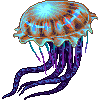Viewing ywjqN

Father: Unknown
Unknown Pedigree
Hardiness: 30
Appearance: 10
Emerged: 3:33 14.02.2024
Matured: 1:49 16.02.2024
Buoyed by internal hydrogen gas sacs, Floranta Doloros are most often spotted in their medusa state, floating among forest canopies at the whim of local air currents. They are incapable of true powered flight but use their suckered tentacles to grasp branches when necessary to shift trajectory. Whether this is an autonomic response to stronger winds or other stimuli is unclear, though Floranta Doloros do not display any other behavior indicating a higher level of intelligence. In their medusa form, they feed on small insects, which they catch on their slightly sticky feeding tentacles. These slender tentacles double as their only defense, bearing stinging nematocysts that deter any would-be predators. During mating season, fertilized eggs are laid in small, sticky clumps on tree leaves. The eggs develop into photosynthetic polyps which, when mature, bud off juvenile Floranta Doloros which then grow into adult medusas.
The creatures that dwell in this rather desolate world still display some diversity in appearance, eating habits, and social behavior. Whether they have fur or feathers, skin or scales, their unique genetic makeup allows for a variety of colors and markings within each species. Despite limitations in food sources, herbivores, omnivores, and carnivores are all present in the food chain, and each species requires specialized care within a laboratory. Although the artificial setting of housing units and breeding pods precludes most opportunities to study true interspecific behavior, the interactions within and between species has been studied extensively in the wilderness by scientists daring enough to venture beyond the outpost’s walls.
